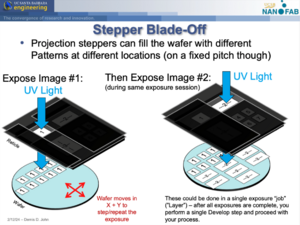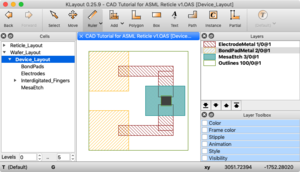Tutorials: Difference between revisions
Jump to navigation
Jump to search

(pasted lins to various mask palges across the wiki) |
(link to liftoff tutorial, new section litho tutorials) |
||
| Line 29: | Line 29: | ||
* [[MLA150 - Design Guidelines]] - for the Heidelberg MLA150 Direct-Writer |
* [[MLA150 - Design Guidelines]] - for the Heidelberg MLA150 Direct-Writer |
||
== Lithography Tutorials == |
|||
Projection litho systems (steppers, direct-writers) usually require a lithography calibration, as follows: |
|||
| ⚫ | |||
*{{fl|Liftoff-Techniques.pdf|Lift-Off Description/Tutorial}} - How it works, process limits and considerations for designing your process. |
|||
| ⚫ | |||
Revision as of 16:05, 29 April 2025
The following are pages to help you design your devices in drawing programs, and make photomasks (aka. "masks" or "reticles") for various systems in our lab.
Drawing Programs
Microfabrication CAD drawings are simple 2D drawings with layers, even though they are intended to become 3D devices through the fabrication process. The fabrication is all top-down, hence only 2D patterning is used.
- Calculators + Utilities > CAD Layout and Mask Design - links to drawing programs and tutorials
- Calculators + Utilities > CAD Design Tips - key concepts you should utilize in your drawings, and tips for setting up your CAD programs
- Calculators + Utilities > Example CAD File - example stepper mask CAD files, including advanced layout for multiple experiments.
- Calculators + Utilities > CAD Files & Templates - example GDS/OAS files for various useful structures (alignment marks, verniers, fonts etc)
Stepper Mask Tutorials

Click for Stepper Reticle Tutorial Stepper Reticle Patterns (“images”) can optionally be much more sophisticated and flexible than contact plates.
- Stepper Reticle Layout vs Wafer Layout (Demis D. John) - explains how Stepper mask layout is very different than other litho systems.
- Stepper Reticle Layout (Advanced) - Complex Experiments and Variations - If you need many design variations on your wafer.
Mask Making Guidelines
- Photomask Ordering Procedure for UCSB Users - see this page for how to submit your order into the purchasing system.
- Stepper Mask-Making Guidelines - Info needed to design and order a reticle for our Stepper systems.
- ASML-specific Mask Making Guidelines (Private) - More detailed info to design and order a reticle for this specific ASML system.
- Access is restricted to trained users only by ASML's requirement - please contact tool supervisor for access.
- Autostep 200 Mask Making Guidance - information on designing and ordering your photomasks for the GCA AutoStep 200.
- GCA 6300 Mask Making Guidance (Work in progress) - GCA 6300 Stepper
- Mask Making Guidelines - Contact Masks - for the MJB-3 & MA6 Contact Aligners
- MLA150 - Design Guidelines - for the Heidelberg MLA150 Direct-Writer
Lithography Tutorials
- Lithography Calibration - Analyzing a Focus-Exposure Matrix (FEM) - Projection litho systems (steppers, direct-writers) usually require a lithography calibration, using a Focus-Exposure Matrix/Array (FEM/FEA).
- Lift-Off Description/Tutorial - How it works, process limits and considerations for designing your process.
